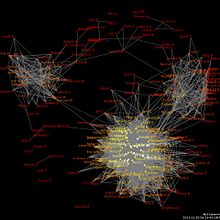Analisis jaringan sosial
Artikel ini sedang dikembangkan sehingga isinya mungkin kurang lengkap atau belum diwikifikasi. Mohon untuk sementara jangan menyunting halaman ini untuk menghindari konflik penyuntingan.
Pesan ini dapat dihapus jika halaman ini sudah tidak disunting dalam beberapa jam. Jika Anda adalah penyunting yang menambahkan templat ini, harap diingat untuk menghapusnya setelah selesai atau menggantikannya dengan {{Under construction}} di antara masa-masa menyunting Anda.
|

Analisis jaringan sosial adalah proses penyelidikan struktur sosial melalui penggunaan jaringan dan teori grafik.[1] Ini mengkarakterisasikan struktur jaringan dalam bentuk simpul (aktor individual, orang, atau benda dalam jaringan) dan ikatan, sisi, atau tautan (hubungan atau interaksi) yang menghubungkannya. Contoh struktur sosial yang umumnya divisualisasikan melalui analisis jaringan sosial meliputi jaringan media sosial,[2][3] penyebaran meme,[4] sirkulasi informasi,[5] jaringan persahabatan dan kenalan, jaringan bisnis, jaringan pengetahuan,[6][7] hubungan kerja yang sulit,[8] grafik kolaborasi, kekerabatan, penularan penyakit, dan hubungan seksual.[9][10] Jaringan ini sering divisualisasikan melalui sosiogram di mana simpul direpresentasikan sebagai titik dan ikatan direpresentasikan sebagai garis. Visualisasi ini menyediakan sarana untuk menilai jaringan secara kualitatif dengan memvariasikan representasi visual simpul dan tepinya untuk mencerminkan atribut yang diinginkan.[11]
Analisis jaringan sosial telah muncul sebagai teknik kunci dalam sosiologi modern. Analisis ini juga memperoleh popularitas signifikan dalam bidang-bidang berikut: antropologi, biologi,[12] demografi, kajian komunikasi,[3][13] ekonomi, geografi, sejarah, ilmu informasi, kajian organisasi,[6][8] fisika,[14] ilmu politik,[15] kesehatan masyarakat,[16][7] psikologi sosial, kajian pembangunan, sosiolinguistik, dan ilmu komputer,[17] pendidikan dan penelitian pendidikan jarak jauh,[18] dan sekarang tersedia secara umum sebagai alat konsumen (lihat perangkat lunak analisis jaringan sosial).[19][20][21]
Referensi
- ^ Otte, Evelien; Rousseau, Ronald (Desember 2002). "Social network analysis: a powerful strategy, also for the information sciences". Journal of Information Science. 28 (6): 441–453. doi:10.1177/016555150202800601.
- ^ Grandjean, Martin (31 Desember 2016). "A social network analysis of Twitter: Mapping the digital humanities community". Cogent Arts & Humanities. 3 (1). doi:10.1080/23311983.2016.1171458
 .
.
- ^ a b Hagen, Loni; Keller, Thomas; Neely, Stephen; DePaula, Nic; Robert-Cooperman, Claudia (October 2018). "Crisis Communications in the Age of Social Media: A Network Analysis of Zika-Related Tweets". Social Science Computer Review. 36 (5): 523–541. doi:10.1177/0894439317721985. OCLC 7323548177.
- ^ Nasrinpour, Hamid Reza; Friesen, Marcia R.; McLeod, Robert D. (2016-11-22). "An Agent-Based Model of Message Propagation in the Facebook Electronic Social Network". arΧiv:1611.07454 [cs.SI].
- ^ Grandjean, Martin (2022). "The Paris/Geneva Divide. A Network Analysis of the Archives of the International Committee on Intellectual Cooperation of the League of Nations" (PDF). Culture as Soft Power: Bridging Cultural Relations, Intellectual Cooperation, and Cultural Diplomacy (dalam bahasa Inggris): 65–98. doi:10.1515/9783110744552-004.
- ^ a b Brennecke, Julia; Rank, Olaf (May 2017). "The firm's knowledge network and the transfer of advice among corporate inventors—A multilevel network study". Research Policy. 46 (4): 768–783. doi:10.1016/j.respol.2017.02.002.
- ^ a b Harris, Jenine K.; Luke, Douglas A.; Zuckerman, Rachael B.; Shelton, Sarah C. (June 2009). "Forty Years of Secondhand Smoke Research". American Journal of Preventive Medicine. 36 (6): 538–548. doi:10.1016/j.amepre.2009.01.039. OCLC 6980180781. PMID 19372026.
- ^ a b Kesalahan pengutipan: Tag
<ref>tidak sah; tidak ditemukan teks untuk ref bernamaBrennecke2019 - ^ Pinheiro, Carlos A.R. (2011). Social Network Analysis in Telecommunications. John Wiley & Sons. hlm. 4. ISBN 978-1-118-01094-5.
- ^ D'Andrea, Alessia; et al. (2009). "An Overview of Methods for Virtual Social Network Analysis". Dalam Abraham, Ajith. Computational Social Network Analysis: Trends, Tools and Research Advances. Springer. hlm. 8. ISBN 978-1-84882-228-3.
- ^ Grunspan, Daniel (23 Januari 2014). "Understanding Classrooms through Social Network Analysis: A Primer for Social Network Analysis in Education Research". CBE: Life Sciences Education. 13 (2): 167–178. doi:10.1187/cbe.13-08-0162. PMC 4041496
 . PMID 26086650.
. PMID 26086650.
- ^ Tringali, Angela; Sherer, David L.; Cosgrove, Jillian; Bowman, Reed (10 Februari 2020). "Life history stage explains behavior in a social network before and during the early breeding season in a cooperatively breeding bird". PeerJ. 8: e8302. doi:10.7717/peerj.8302
 . PMC 7020825
. PMC 7020825  . PMID 32095315.
. PMID 32095315.
- ^ Social network differences of chronotypes identified from mobile phone data. 2018. OCLC 1062367169.[halaman dibutuhkan]
- ^ Gao, Min; Li, Zheng; Li, Ruichen; Cui, Chenhao; Chen, Xinyuan; Ye, Bodian; Li, Yupeng; Gu, Weiwei; Gong, Qingyuan; Wang, Xin; Chen, Yang (Oktober 2023). "EasyGraph: A multifunctional, cross-platform, and effective library for interdisciplinary network analysis" (PDF). Patterns. 4 (10): 100839. doi:10.1016/j.patter.2023.100839. PMC 10591136
 Periksa nilai
Periksa nilai |pmc=(bantuan). PMID 37876903 Periksa nilai|pmid=(bantuan). - ^ Kim, Rakhyun E (26 November 2020). "Is Global Governance Fragmented, Polycentric, or Complex? The State of the Art of the Network Approach". International Studies Review. 22 (4): 903–931. doi:10.1093/isr/viz052
 .
.
- ^ Harris, Jenine K.; Clements, Bruce (July 2007). "Using Social Network Analysis to Understand Missouri's System of Public Health Emergency Planners". Public Health Reports. 122 (4): 488–498. doi:10.1177/003335490712200410. OCLC 8062393936. PMC 1888499
 . PMID 17639652.
. PMID 17639652.
- ^ Ghanbarnejad, Fakhteh; Saha Roy, Rishiraj; Karimi, Fariba; Delvenne, Jean-Charles; Mitra, Bivas (2019). Dynamics On and Of Complex Networks III Machine Learning and Statistical Physics Approaches. Cham: Springer International Publishing : Imprint: Springer. ISBN 9783030146832. OCLC 1115074203.[halaman dibutuhkan]
- ^ Bozkurt, Aras; Akgun-Ozbek, Ela; Yilmazel, Sibel; Erdogdu, Erdem; Ucar, Hasan; Guler, Emel; Sezgin, Sezan; Karadeniz, Abdulkadir; Sen-Ersoy, Nazife; Goksel-Canbek, Nil; Dincer, Gokhan Deniz; Ari, Suleyman; Aydin, Cengiz Hakan (2015-01-20). "Trends in distance education research: A content analysis of journals 2009–2013". The International Review of Research in Open and Distributed Learning (dalam bahasa Inggris). 16 (1). doi:10.19173/irrodl.v16i1.1953
 . ISSN 1492-3831.
. ISSN 1492-3831.
- ^ "Facebook friends mapped by Wolfram Alpha app". BBC News. 24 September 2012. Diakses tanggal 25 Juli 2016.
- ^ Frederic Lardinois (30 Agustus 2012). "Wolfram Alpha Launches Personal Analytics Reports For Facebook". Tech Crunch. Diakses tanggal 25 Juli 2016.
- ^ Ivaldi M.; Ferreri L.; Daolio F.; Giacobini M.; Tomassini M.; Rainoldi A. "We-Sport: from academy spin-off to data-base for complex network analysis; an innovative approach to a new technology". J Sports Med Phys Fitness. 51 (suppl. 1 to issue 3). hdl:2318/90491.
The social network analysis was used to analyze properties of the network We-Sport.com allowing a deep interpretation and analysis of the level of aggregation phenomena in the specific context of sport and physical exercise.
